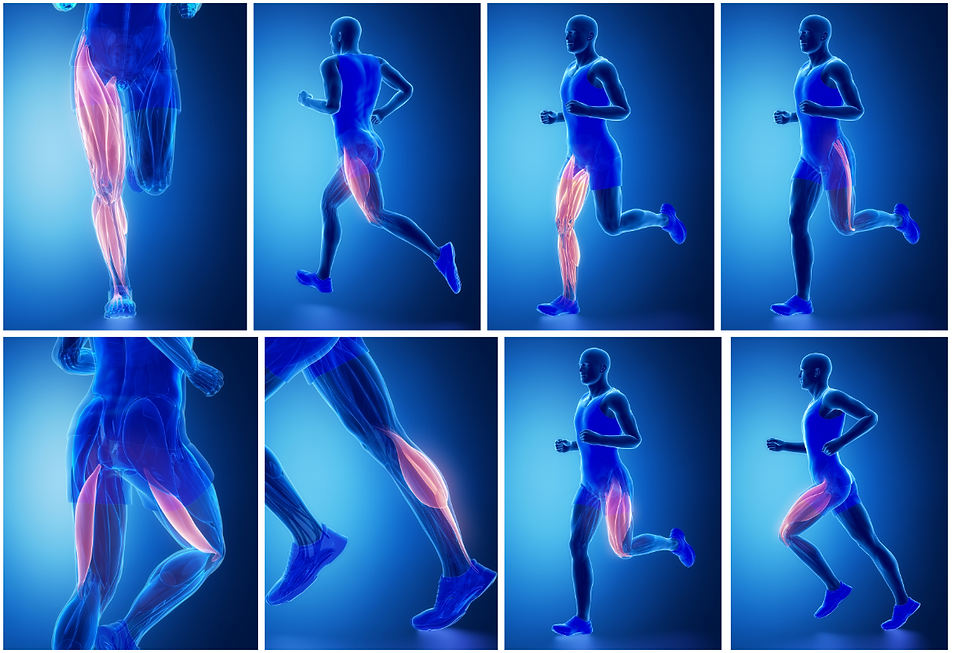Strength Training for Runners: The best Exercise for a Strong Foundation
- Fabio Abbruzzesi

- Jan 22
- 5 min read
The Importance of Strength Training for Runners
Running is more than just putting one foot in front of the other. Behind every stride is a symphony of muscles, power, and balance. Strength training can elevate your running, making you faster, more efficient, and less prone to injury. In this post, we’ll explore how every runners can incorporate strength training, plyometrics, and power exercises into their routine, focusing on the key muscle groups involved and providing simple yet effective workout routines. Let’s get started!
Types of Workout
For runners, strength training comes in many forms, each offering unique benefits. The good news? You don’t need a fancy gym to start. While some exercises require equipment like dumbbells or boxes, many can be done at home with minimal gear. Here are the key types of training:
1. Strength Training
Strength training involves exercises designed to increase the force your muscles can produce. For runners, this enhances running economy (using less energy at a given pace), improves speed, and helps prevent injuries. Incorporating strength and conditioning into your routine can make you a better runner and reduce injury risks.
Key Benefits:
Better endurance and speed.
Reduced risk of conditions like shin splints or runner’s knee.
Improved overall bone density and joint health.
2. Plyometrics
Plyometric exercises involve explosive movements, teaching your muscles to generate force quickly. This is especially helpful for powering through hills or finishing a race strong.
Examples: Diagonal pogo jumps, drop jumps.
Focus: Spend minimal time on the ground to train quick reaction and power.
3. Power Exercises
Power exercises bridge the gap between strength and speed. They focus on the quality of force generated in a short period of time, making them critical for sprinting or accelerating efficiently.
Examples: Box jumps, explosive step-ups.
Progression: Start with low heights and gradually increase as you build confidence.
Muscles Involved in Running
Running engages multiple muscle groups, each playing a specific role in your performance:
Glutes: Essential for hip stability and forward propulsion.
Key Exercises: Single-leg deadlifts, side plank hip abductions.
Quadriceps: Located at the front of your thighs, these muscles are responsible for knee extension and controlling impact during landing.
Key Exercises: Bulgarian split squats, lateral step-downs.
Calves: Crucial for ankle plantarflexion (pushing off the ground) and forward momentum.
Key Exercises: Single-leg heel raises, seated deficit heel raises.
Hamstrings: Active during the swing phase of running, they decelerate the leg and aid propulsion.
Key Exercises: Nordic hamstring curls, single-leg deadlifts.
Core: A strong core stabilizes your torso (abs and lower back), enabling efficient force transfer and reducing unnecessary motion.
Key Exercises: Planks, side bridges with hinge.
Upper Body: Although running is lower-body dominant, your arms and shoulders contribute to balance and rhythm.
Key Exercises: Mountain climbers, push-ups, superman.

What Strength Exercises Are Best for Runners?
When it comes to strength training, exercises can be broadly categorized into bodyweight and weight training. Each has its own benefits and is suited to different stages of your fitness journey. Bodyweight exercises are excellent for mastering form and building a solid foundation, while overloaded exercises introduce additional resistance to challenge your muscles further and accelerate strength gains.
Bodyweight Exercises:
Ideal for beginners.
Focus on form and balance.
Example: Bodyweight squats, planks.
Weight Training:
Use additional weight (like dumbbells) to build strength.
More effective for targeting specific muscles.
Example: Dumbbell deadlifts, weighted step-ups.
Tip for Beginners: Start with bodyweight exercises to master technique before adding weights.
Always prioritize proper form, posture and technique, as incorrect form can lead to injuries or strain. Focus on controlled movements and use an intensity that challenges you without compromising your alignment.

Best Strength Exercises for Runners
Here are three simple and progressive workouts tailored to beginner runners. Perform these routines twice a week, allowing at least one rest day between sessions.
Workout 1: Bodyweight Basics
Those strength exercises focuse on strengthening foundational muscles essential for running efficiency and injury prevention. The exercises target the glutes, core, and lower body, improving stability, balance, and endurance.
Bodyweight Squat – 3 sets of 10-12 reps.
Plank – Hold for 20-30 seconds, 3 rounds.
Single-Leg Deadlift (Bodyweight) – 2 sets of 8 reps per leg.
Forward Lunge – 2 rounds of 10 reps per side.
Mountain Climbers – 3 sets of 20 seconds.
Workout 2: Introduction to Plyometrics
This routine is designed to develop explosive strength and improve the rate of force production, which is crucial for powering up hills, quick accelerations, and strong finishes. It targets the lower body muscles, particularly the calves, quadriceps, and glutes, while also engaging the core for stability.
Diagonal Pogo Jumps – 3 sets of 20 seconds.
Drop Jumps – 3 sets of 6-8 reps.
Single-Leg Heel Raise – 2 sets of 12 reps per leg.
Plank with Arm Lift – 3 rounds, hold for 20 seconds per arm.
Sumo Squat – 3 sets of 10-12 reps.
Workout 3: Strength and Power Combo
This routine combines strength and explosive power to enhance overall running performance. It focuses on building muscle strength, improving coordination, and developing quick force generation for better sprints and strong finishes. The exercises target the glutes, hamstrings, quads, and core, ensuring a full-body workout to support running efficiency.
Box Jumps – 3 sets of 6 reps.
Bulgarian Split Squat (Bodyweight or Dumbbells) – 2 sets of 8 reps per leg.
Seated Deficit Heel Raise – 3 sets of 10 reps.
Side Plank with Hinge – 3 rounds of 8-10 reps per side.
Explosive Step-Ups – 2 sets of 10 reps per leg.
Want to discover more exercises for runner? Check out my personalized training plans to discover how to seamlessly integrate these routines into your schedule and achieve your goals faster.
How much Strength Training do Runners need to do?
How much strength training runners need depends on their experience and goals. For beginners, starting with one session per week is ideal to adapt and avoid excessive soreness. Runners with some prior experience can benefit from two sessions, while seasoned runners might incorporate up to three sessions per week, ensuring recovery between workouts. Align strength training with hard training days and reserve easy or rest days for recovery. The focus should be on controlled, run-specific movements using manageable weights or resistance. Short but consistent sessions, ranging from 10 to 25 minutes, can be effective. By progressing gradually and maintaining proper form, runners can enhance performance and minimize risk of injury.
Conclusions
Strength training is vital for beginner runners to improve performance and reduce injury risk.
Focus on exercises targeting the glutes, quads, calves, hamstrings, and core.
Start with bodyweight exercises to master form, then progress to weighted and explosive movements.
Consistency is key—perform strength training 2-3 times per week and allow for recovery.
Incorporating these routines into your weekly schedule will not only boost your running but also make your body more resilient. So lace up those running shoes and pair your miles with strength—your future self will thank you!
Have a favorite strength routine? Have a special secret to enhance your running performance? Share it in the comments below and let’s create a space where runners can exchange tips and inspire each other!




Comments